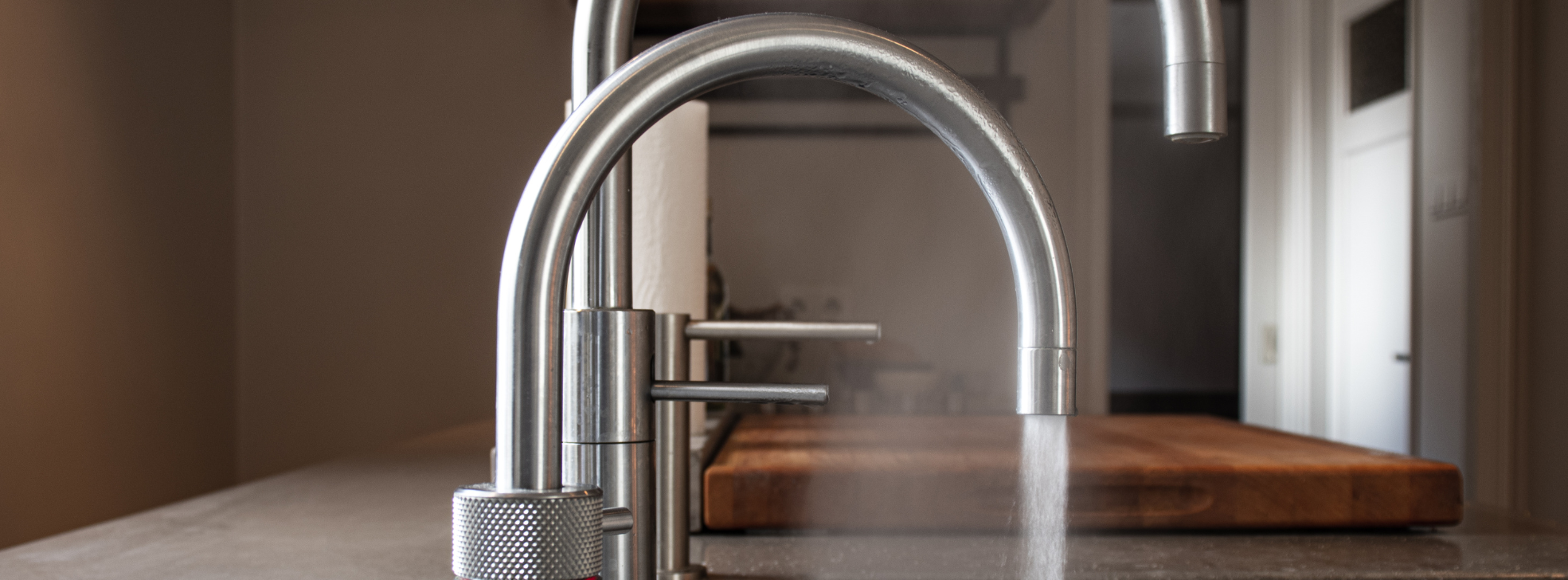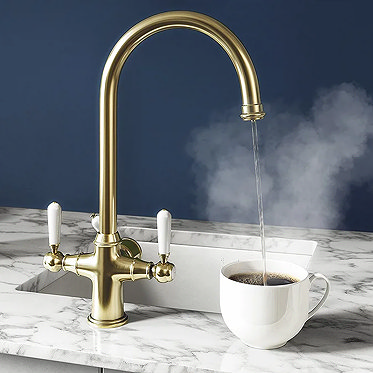UP TO 60% OFF PRICE DROP SALE!
Free Delivery on Orders Over £499**
Boiling Water Taps Buying Guide
Boiling Water Taps Buying Guide
Choose the best boiling water tap for your kitchen

Say goodbye to kettle watching. Boiling water taps are fast becoming a must-have feature in modern UK kitchens. In this no-faff boiling water tap buying guide, we’ll walk you through what they do, how they work, what to look out for and which ones are worth your money. Whether you’re giving your kitchen a quick glow up or going full kitchen reno, we’ve got the need-to-knows that’ll help you boss the decision.
For First Time Boiling Water Tap Buyers
What is a Boiling Water Tap?
A boiling water tap is exactly what it sounds like, a tap that gives you near-boiling water on demand. Most run around 98°C, which is perfect for tea, cooking, and all those jobs where a kettle used to step in. The magic happens thanks to a compact, insulated boiler tank that sits neatly under your sink. You flick a handle or push a button, and boom. Instant heat.
Here's how it works:
- Water is stored just below 100°C in a compact under-sink tank
- When you use it, fresh cold water fills the tank and reheats automatically
- Some taps are boiling-only, while others combine hot, cold, and boiling all in one
- You’ll need a regular 13A plug under the sink to power it
Boiling Tap Basics (3-in-1 vs. 4-in-1)
- 2-in-1 or Standalone: Only dispenses boiling (and sometimes filtered cold) water; typically installed alongside a normal mixer tap.
- 3-in-1 Taps: The most popular choice, combining regular hot, regular cold, and boiling water in one faucet. A separate handle or button usually controls the near-boiling flow.
- 4-in-1 Taps: Adds filtered cold (and occasionally sparkling water) on top of the 3-in-1 functions—ideal if you want to eliminate bottled water or a separate filter jug.
In all cases, the under-sink tank continuously heats and stores water, ensuring instant near-boiling flow on demand.
Key Benefits Of Boiling Water Taps
Speed & Convenience
With instant hot water, there's no need to wait for a kettle to boil, making it ideal for those who frequently prepare tea or coffee, cook pasta, blanch vegetables, or quickly soak pots.
Energy Efficiency
An insulated tank helps maintain temperature using very low standby power (often around 10 watts), and by avoiding the common habit of over-boiling kettles, it may help reduce electricity bills.
Some boiling water taps cost as little as 3p per day to run, compared to a kettle costing around 2.5p per boil.
Worktop Decluttering
You no longer need to keep a kettle on the counter, helping to create a cleaner, more streamlined kitchen aesthetic
Multi-Use Versatility
This system is excellent for rinsing, prepping meals quickly, and sterilising utensils. Additionally, a 4-in-1 tap can provide filtered chilled water, eliminating the need for separate filtration devices.
Potential Cost Savings
Although the upfront cost is typically higher than a standard kettle, users may benefit from long-term energy and time savings.
Busy families or offices, in particular, could save a surprising amount of time and reduce daily kitchen hassle.
Popular Boiling Water Tap Styles & Finishes
Modern, Minimalist Taps
Sleek J- or L-shaped spouts, chrome or matte black finishes, sometimes digital touch controls.
Suited for contemporary kitchens with steel appliances or industrial themes.
Traditional or Heritage Designs
Bridge-style, ornate spouts, ceramic lever handles, finishes like antique brass or polished nickel.
Perfect for farmhouse sinks or classic shaker kitchens.
Common Finishes
- Polished Chrome (most common, budget-friendly)
- Brushed Steel/Nickel (soft, contemporary)
- Matt Black (bold statement)
- Brass/Copper (on-trend for luxe or vintage vibes)
- Niche options: gunmetal grey, colored enamels, etc.
Space & Installation Essentials For Your Boiling Water Tap
Cupboard Space
The under-sink boiler tank typically fits in the kitchen cupboard. Check dimensions; common tank sizes are 2–4 litres, about the size of a small toaster.
Power Supply
Needs a standard 13A socket under the sink. If none exists, you’ll need an electrician to install one.
Water Pressure
Most boiling taps work best with 1–5 bar mains pressure. Gravity-fed or very low-pressure systems may require a compatible low-pressure tap or a pump.
Boiling water taps also run at a lower flow pressure than standard hot/cold taps, helping to prevent splashing and making them safer to use.
Tap Hole
Most 3-in-1 taps fit a 35mm standard hole. Some traditional “bridge” designs need two holes.
Boiling taps are usually monobloc designs (one hole, single-body construction). If you're replacing separate hot and cold taps, you may need a new sink or an adapter to consolidate into a single fitting.
Installation
Professional fitting is strongly recommended.
Basic Cost Overview For A Boiling Water Tap
Entry-Level (~£300–£500)
- Basic 3-in-1 kits, smaller ~2.4L tanks, often limited finishes (mainly chrome).
- Perfect for those wanting an affordable, functional system.
Mid-Range (~£500–£800)
- Wider brand choices, possibly 4-in-1 capabilities.
- Better build quality (solid brass bodies, digital tank controls), more finish options (brushed, black, etc.).
High-End (£900+)
- Premium brands (e.g. top-tier Grohe/Abode lines) with advanced tech (pressurised 100°C, app connectivity, or vacuum-insulated tanks).
- Larger tank capacities (4–5L), luxurious finishes (brass, gunmetal), robust warranties, and extra features like sparkling water.
For Savvy Boiling Water Tap Shoppers
Filtration & Limescale Prevention
Inline Carbon Filters
- Removes chlorine, sediment, and reduces limescale—a must in hard-water regions.
- Protects the tank’s heating element from scale buildup, preserving longevity.
Filter Replacement
- Usually every 3–6 months (or per brand instructions). Filter costs vary from ~£30 to £100.
- Some brands offer digital reminders; others have a simple time-strip or manual check.
De-scaling
- If you live in an area with very hard water, occasional tank descaling (using vinegar or citric acid) may be necessary—even with filtration.
Boiling Water Tap Safety Features
Two-Step Controls
- Press down + turn, or hold a button + turn, ensuring no accidental boiling flow.
- Some taps have an electronic safety lock (e.g., Grohe Red’s double-button system).
Cool-Touch Spout
- Internal insulation keeps the tap’s exterior comfortable to touch even after dispensing.
Auto Shut-Off
- Water stops immediately if you release the handle, preventing continuous boiling flow.
Visible Indicators
- LEDs or red markings show when boiling mode is active—alerting anyone nearby to the high temperature.
Child-Proof Mechanisms
- Premium systems like Abode HotKey require a magnetic fob to unlock boiling water.
Top Boiling Tap Brands
Let’s be real — not all instant-hot taps are made equal. Some are built to last. Some are built to look the part. And the best ones? They do both. Here are five of the brands we rate:
- Abode – Pronteau range with the HotKey magnetic safety-fob, a broad palette of finishes, and reliable UK after-sales support.
- Bower – Budget-friendly entry point offering both contemporary and heritage styles without skimping on build quality.
- Grohe – German engineering; the Red series delivers a 5-year warranty, electronic child-lock, and true-boil pressurised technology.
- Reginox – Well-priced 3-in-1 kits, easy filter changes, and robust mid-range warranties for everyday reliability.
- The Tap Factory – Eye-catching colour options, compact 2.4 L tanks, and running-cost claims of under 1 p per cup.
Heads-up: stock, prices and finishes can shift — always check the product page for the latest.
Frequently Asked Questions About Boiling Water Taps
How do boiling water taps compare to kettles on energy use?
Insulated tanks can be more efficient for frequent use. Kettles often waste energy from overfilling.
Are they truly safe for families with children?
Yes. Reputable taps use two-step handles, cool-touch spouts, and auto shut-off. Many consider them safer than handling a heavy kettle of boiling water.
What if I need 100°C water for sterilising baby bottles?
Most taps provide ~98°C; some premium pressurised models (Quooker, certain Grohe) reach true 100°C.
Will I need to descale the tank?
Possibly. If you’re in a hard-water area, regular filter changes and occasional descaling keep the system running smoothly.
Boiling It All Down
A boiling tap isn’t just a fancy extra — it’s a proper upgrade for your kitchen. It saves space, saves time, and makes your old kettle look, frankly, a bit tired. Whether you want something simple and smart or all the bells and whistles, the trick is choosing the right setup for your space and lifestyle.
Think about tank size. Check your water pressure. Look at safety features. And don’t forget the finish — because let’s face it, if it’s going to sit pride of place, it should look the part.
Get it fitted right, keep it maintained, and you’ll wonder how you ever lived without it.

